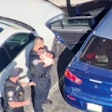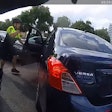When the management of law enforcement video manufacturer Digital Ally decided last year to branch out into some new markets, they decided very quickly that speed measurement was a natural.
"In-car video and speed enforcement are sold to the same person in the department, so it just made a lot of sense to pursue this market," explains Ken McCoy, Digital Ally's vice president of sales and marketing.
It also made sense given McCoy's history. He'd worked in the speed enforcement product market for decades and he knew he had a sales and support team ready to make a Digital Ally LIDAR (Light Detection and Ranging) measurement system a success. All he needed was an outstanding product that his team could put in the hands of Digital Ally's customers.
McCoy decided to seek out Scott Patterson, former owner of Lasercraft, to engineer the product. "I knew him from previous projects so when we decided to go into this market, I knew we wanted his experience," McCoy explains.
With Patterson and his team of engineers on board, the Digital Ally LIDAR system went from concept to reality in about a year. "The engineers had many years of experience so it wasn't like we were starting out cold," McCoy says.
The result of all this engineering and planning is the LaserAlly LIDAR system. And the company is already taking orders for the product. "We're getting rave reviews from the departments we show it to," McCoy says.
McCoy says the LaserAlly system has several key features that make it an outstanding speed measurement tool.
The LaserAlly weighs only 2.5 pounds. "That's about a half pound lighter than many of its competitors," McCoy says. "I know that doesn't sound like much but, in a handheld device, half a pound is significant."
Customers also like the way the LaserAlly system feels in their hands, according to McCoy. "It balances really well," he says. "Some LIDAR systems are nose heavy. We avoided that with this one."
McCoy says another key selling point for the LaserAlly system is its range. The system has a maximum range of about 1,500 feet when shot through glass and about 6,000 feet when not shooting through a window or windshield. "That gives you a really long tracking history, which is important in court," McCoy says. Target acquisition time, even at the extreme ranges, is less than a third of a second.
Another great feature in the LaserAlly is its "Obstruction Mode." If there's a sign or pole between you and the lane of traffic that you want to monitor, all you have to do is shoot the obstruction using obstruction mode and the LaserAlly will record its exact distance and ignore any object at that location.
Digital Ally's new LIDAR system is also likely to bring some surprises to highway scofflaws. The LaserAlly has some advanced anti-jamming capabilities. "We have the only LIDAR system that can read a vehicle that's equipped with a jammer and the jammer will not detect our system and can't jam our system," McCoy says.
McCoy says that despite all of the advanced features in the LaserAlly system the LIDAR is easy to use. "It's very user friendly," he adds. Some guns you have to study manuals and learn menus to use them. We didn't want that with this system. You can pick this unit up, squeeze the trigger to turn it on, and you're ready to go out and do work. It's very intuitive."
LaserAlly was recently listed on the International Association of Chiefs of Police (IACP) Conforming Product List (CPL) for enforcement-technology equipment.


















